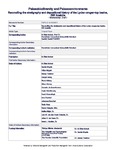Reconciling the stratigraphy and depositional history of the Lycian orogen-top basins, SW Anatolia
| dc.contributor.author | Alçiçek, MC | |
| dc.contributor.author | Mayda, S | |
| dc.contributor.author | ten Veen, JH | |
| dc.contributor.author | Boulton, Sarah | |
| dc.contributor.author | Alçiçek, H | |
| dc.contributor.author | Tesakov, AS | |
| dc.contributor.author | Saraç, G | |
| dc.contributor.author | Hakyemez, HY | |
| dc.contributor.author | Göktaş, F | |
| dc.contributor.author | Murray, AM | |
| dc.contributor.author | Jiménez-Moreno, G | |
| dc.contributor.author | Büyükmeriç, Y | |
| dc.contributor.author | Wesselingh, FP | |
| dc.contributor.author | Demirel, FA | |
| dc.contributor.author | Bouchal, JM | |
| dc.contributor.author | Kaya, TT | |
| dc.contributor.author | Halaçlar, K | |
| dc.contributor.author | Bilgin, M | |
| dc.contributor.author | van den Hoek Ostende, LW | |
| dc.date.accessioned | 2019-03-19T09:29:18Z | |
| dc.date.issued | 2019-12 | |
| dc.identifier.issn | 1867-1594 | |
| dc.identifier.issn | 1867-1608 | |
| dc.identifier.uri | http://hdl.handle.net/10026.1/13495 | |
| dc.description.abstract |
Terrestrial fossil records from the SW Anatolian basins are crucial both for regional correlations and palaeoenvironmental reconstructions. By reassessing biostratigraphic constraints and incorporating new fossil data, we calibrated and reconstructed the late Neogene and Quaternary palaeoenvironments within a regional palaeogeographical framework. The culmination of the Taurides in SW Anatolia was followed by a regional crustal extension from the late Tortonian onwards that created a broad array of NE-trending orogen-top basins with synchronic associations of alluvial fan, fluvial and lacustrine deposits. The terrestrial basins are superimposed on the upper Burdigalian marine units with a c. 7 myr of hiatus that corresponds to a shift from regional shortening to extension. The initial infill of these basins is documented by a transition from marginal alluvial fans and axial fluvial systems into central shallow-perennial lakes coinciding with a climatic shift from warm/humid to arid conditions. The basal alluvial fan deposits abound in fossil macro-mammals of an early Turolian (MN11–12; late Tortonian) age. The Pliocene epoch in the region was punctuated by subhumid/humid conditions resulting in a rise of local base levels and expansion of lakes as evidenced by marsh-swamp deposits containing diverse fossil mammal assemblages indicating late Ruscinian (late MN15; late Zanclean) age. A second pulse of extension, accompanied by regional climatic changes, prompted subsequent deepening of the lakes as manifested by thick and laterally extensive carbonate successions. These lakes, which prevailed c. 1 myr, later shrank due to renewed progradation of alluvial fans and eventually filled up and dried out, reflected by marsh-swamp deposits at the top of a complete lacustrine succession that contains diverse micro-mammal assemblages indicating a latest Villanyian (MN17; Gelasian) age. A third pulse of tectonic reorganisation and associated extension dissected the basins into their present-day configuration from the early Pleistocene onwards under warm/humid climatic conditions. The new age data provide means to correlate deposits across various basins in the region that help to place the basin development into a regional tectonic framework, which can be attributed to the consequence of the well-articulated regional phenomena of slab-tear/detachment-induced uplift followed by crustal extension and basin formation (late Tortonian), the outward extension of the Aegean arc (early Pliocene) and eventually accompanied by westward extrusion of the Anatolian Plate (early Pleistocene). | |
| dc.format.extent | 551-570 | |
| dc.language | en | |
| dc.language.iso | en | |
| dc.publisher | Springer Science and Business Media LLC | |
| dc.subject | Correlation | |
| dc.subject | Synchronicity | |
| dc.subject | Palaeoenvironments | |
| dc.subject | Mammal | |
| dc.subject | Post-orogeny | |
| dc.subject | Taurides | |
| dc.title | Reconciling the stratigraphy and depositional history of the Lycian orogen-top basins, SW Anatolia | |
| dc.type | journal-article | |
| dc.type | Journal Article | |
| plymouth.author-url | https://www.webofscience.com/api/gateway?GWVersion=2&SrcApp=PARTNER_APP&SrcAuth=LinksAMR&KeyUT=WOS:000502451700002&DestLinkType=FullRecord&DestApp=ALL_WOS&UsrCustomerID=11bb513d99f797142bcfeffcc58ea008 | |
| plymouth.issue | 4 | |
| plymouth.volume | 99 | |
| plymouth.publication-status | Published | |
| plymouth.journal | Palaeobiodiversity and Palaeoenvironments | |
| dc.identifier.doi | 10.1007/s12549-019-00394-3 | |
| plymouth.organisational-group | /Plymouth | |
| plymouth.organisational-group | /Plymouth/Faculty of Science and Engineering | |
| plymouth.organisational-group | /Plymouth/Faculty of Science and Engineering/School of Geography, Earth and Environmental Sciences | |
| plymouth.organisational-group | /Plymouth/REF 2021 Researchers by UoA | |
| plymouth.organisational-group | /Plymouth/REF 2021 Researchers by UoA/UoA07 Earth Systems and Environmental Sciences | |
| plymouth.organisational-group | /Plymouth/Users by role | |
| plymouth.organisational-group | /Plymouth/Users by role/Academics | |
| dcterms.dateAccepted | 2019-03-05 | |
| dc.rights.embargodate | 2019-9-14 | |
| dc.identifier.eissn | 1867-1608 | |
| dc.rights.embargoperiod | Not known | |
| rioxxterms.versionofrecord | 10.1007/s12549-019-00394-3 | |
| rioxxterms.licenseref.uri | http://www.rioxx.net/licenses/all-rights-reserved | |
| rioxxterms.type | Journal Article/Review |


